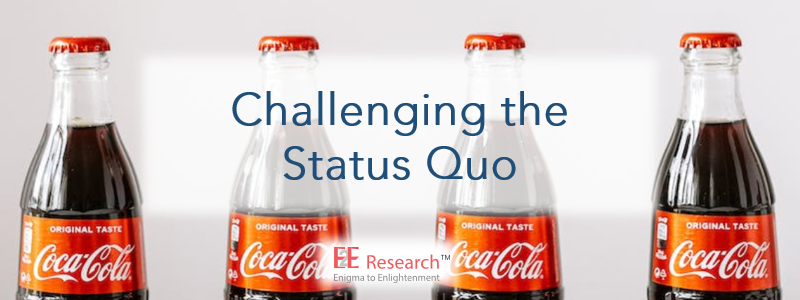
Market research is all about disrupting the status quo.
We aim to discover what the average person likes or dislikes about a brand and then improve those things to increase our chances of success. We try to change perceptions about brands people think they don’t like so that they’ll switch to our brand. We work really hard to change other people’s attitudes and behaviors.
But what are we changing about ourselves?
Humans use routine and cognitive biases to simplify and speed up their decision-making processes, and marketing research is overflowing with those routines.
Why do we use the same 30-minute tracker or U&A questionnaire every year?
Sure, we want to create norms and benchmarks so we can see what has changed and where we’ve improved. But how could it possibly be that we were so incredibly smart that THIS 30-minute tracker is precisely, exactly what we need forever and always?
- Perhaps today is a great day to change it into three 10-minute questionnaires so that people can remain fully engaged through-out and not worry about finishing in time to pick-up their kids.
- Perhaps today is a great day to remove the 10 minutes of questions that we’ve never acted on.
- Perhaps today is the day we throw the whole thing in the recycle folder and brainstorm a completely new, far more engaging and actionable way to ask about our brand.
Why do we always default to questionnaires/groups/social listening?
Sure, we’ve written so many questionnaires that we’re experts at it. We could write a 30-minute questionnaire in 20 minutes. So how come someexpert researchers have never written one?
- If you’ve never personally participated in a focus group, maybe now is the perfect time to try one so you can truly dig deep into the psyche of your buyers and users.
- If you don’t trust biometrics, why not try one study just to prove yourself right – or wrong.
- Why not take a class in interviewing or moderating so you’ll be just as comfortable defaulting to qualitative research when that method better suits the research objective?
- Why not build a better tool box so you’ll be able to gather the precise insights you need rather than the insights that happen to be available at that moment?
Why do we always use the same sample sizes?
How is it statistically possible that n=300 is the best sample size to choose a nice color for a package and also the right sample size to choose a drug that will save 5 out 100,000 lives rather than just 4?
- You may not like statistics but maybe the true statement is you don’t like statistics yet. Finding the right instructor can make all the difference.
- Have you learned in detail what effect sizes are and how they affect sample sizes? Maybe 300 is correct, but maybe you actually only need 200.
- Have you tried running the exact same study twice but with sample sizes of only 30? Seeing just how different those results are is a good reminder that random chance is real, and reliability and validity are important for generating actionable recommendations.
- Have you tried generalizing research findings from a community survey of 30 Black people to 300 million white people? Over-sampling under-represented people is not a luxury – it’s a necessity.
There are so many good reasons to create time-saving templates and cognitive rules, but also so many reasons to ignore them. You need to ensure you’re making the choice for yourself rather than defaulting to a template for reasons of speed. That’s how we end up making great decisions.
Podcasts You Might Like
- Change by Attraction with Esther Derby
- Change on the Run with Phill Buckley
- Change Management Review
- Conversations of Agile Change with Dr Jen Frahm and Lena Ross
- Two Minutes of Talking Change with Jennifer Campbell